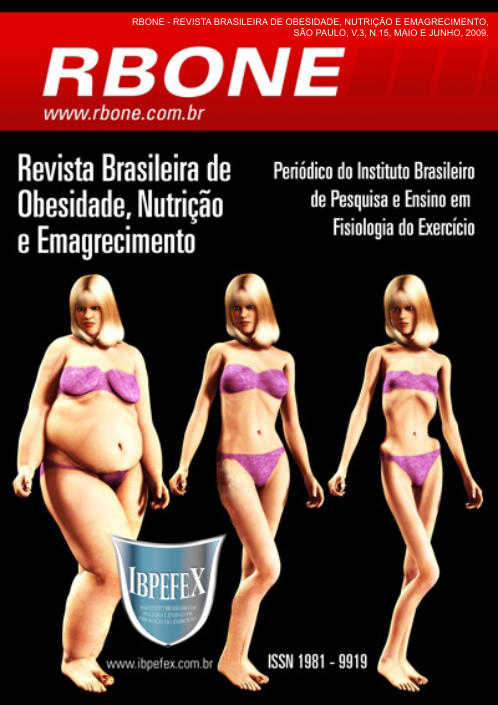Gut microbiota and its relationship with obesity
Abstract
Obesity is a chronic disease characterized by excessive accumulation of body fat, that can cause several problems to the health in a short or long range, being considered, currently, the biggest nutritional disorder of developed and developing countries. Microbiota can be seen as a metabolic organ synergistically adjusted to our physiology, wich plays important roles in the maintaining and defense of our organism. Recent data suggests that trillions of bacteria witch normally reside in the human gastro-intestinal tract affect the acquisition and regulation of energy, but they still suggest that lean and obese people have different microbiota. This work aimed to verify, through a bibliographic search, the relation between obesity and gut microbiota composition. It was verified in different studies, performed in humans and rats, lean and obese, that the obesity is associated with the relative change of the bacteria’s “Bacterioides and Firmicutes”. These changes affect the metabolic potential of the gut microbiota of rats, where the micro-biota of the obese has a greater capacity of energy-absorption from the diet. It was also concluded that there is a bigger number of “Staphylococcos Aureus”. Realized that when obese patients lost weight, the proportion of Fermicutes became similar to the lean individuals. However, additional studies are necessary for better clarifying this relation between gut microbiota and obesity.
References
- Bäckhed, F.; e colaboradores. Mechanisms underlyng the resistance to diet-induced obesity in germ-free mice. PNAS. Vol. 104. Num. 3. 2007. p. 979-984.
- Bäckhed, F.; e colaboradores. The gut microbiota as an environmental factor that regulates fat storage. PNAS. Vol. 101. Num. 44. Nov. 2004. p. 15718-15723.
- Brandt, K.G.; Sampaio, M.M.S.C.; Miuki, C.J. Importância da microflora intestinal. Revisões e ensaios de Pediatria. São Paulo. Vol. 28. Num. 2. 2006. p. 117-127.
- Choban, O.S.; e colaboradores. Bariatric surgery for morbid obesity: why, when and tren what? Cleve Clin J Med. Vol. 69. 2002. p. 897-903.
- Collado, M.C.; e colaboradores. Distinct composition of gut microbiota during pregnancy in overweight and normal-weight women. Am J Clin Nut. Vol. 88. out. 2008. p. 894-899.
- Dâmaso, A.; e colaboradores. Etiologia da obesidade. Cap. 1. p.3-15 Livro: Obesidade. Ana Dâmaso. Ed. Medsi. Guanabara Koogan. Rio de Janeiro, 2003.
- Delzenne, N.M.; Cani, D.C. Gut microflora as a target for energy and metabolic homeostasis. Cur Op in Clin Nut and Met Care. Num. 10. 2007. p. 729-734.
- Dibaise, J.K.; e colaboradores. Gut Microbiota and Its Possible Relationship With Obesity. Mayo Clinic Proceedigs. Vol. 83. Num. 4. 2008. p. 460-469.
- Duarte, A.C.; e colaboradores. Bioquímica e Prescrição Nutricional. Rio de Janeiro. Editora Axcel. p. 18-43. 2005.
- Fandiño, J.; e colaboradores. Cirurgia Bariátrica: aspectos clínico-cirúrgicos e psiquiátricos. Rev de Psiq RS. Vol. 26. Num. 1. jan/abr. 2004. p. 47-51.
- Fandiño, J.; Segala, A. Indicações e contra-indicações para realização das operações bariátricas. Rev Bras de Psiq. Vol. 4. 2002. p. 68-72.
- Francischi, R.P.P.; e colaboradores. Obesidade: atualização sobre sua etiologia, morbidade e tratamento. Rev. Nutr. Campinas, Vol. 13. Num. 1. Jan/abr. 2000. p. 17-28.
- Guarner, F.; Malagelada, Jr. Gut flora in health and disease. Lancet. Nun. 361. 2003. p. 512-519.
- Kalliomäki.; e colaboradores. Early differences inf fecal microbiota composition in children may predict overweight. Am J Clin Nutr. Num. 87. 2008. p. 534-538.
- Ley e colaboradores. Obesity alters gut microbial ecology. Proc Natl Acad Sci USA. Vol. 102. Num. 31. agosto 2005. p. 11070-11075.
- Moraes, T.S. Intervenção Nutricional No Tratamento de Pacientes Obesos. Revista Brasileira de Obesidade, Nutrição e Emagrecimento. Vol. 1. Num. 3. Mai/Jun. 2007. p. 38-46.
- Nunes, A.M.; e colaboradores. Transtornos Alimentares e Obesidade. 2ª edição. Porto Alegre: Artmed, 2006.
- Pinheiro, A.R.O.; Freitas, S.F.T.; Corso, A.C.T. Uma Abordagem Epidemiológica da Obesidade. Rev Nut Campinas. Vol. 17. Num. 4. 2004. p. 523-533.
- Povoa, H. O cérebro desconhecido: como o sistema digestivo afeta nossas emoções, regula nossa imunidade e funciona como um órgão inteligente. Rio de Janeiro, 2002. Editora Objetiva.
- Schiffrin, E.J.; Blum, S. Interactions between the microbiota and the intestinal mucosa. Eur J Clin Nutr. Vol. 56(Suppl 3). 2002. p. S60-S64.
- Tannock, G.W. The normal microflora: an introduction. In: Tannock GW, ed. Medical importance of normal micro-flora. Netherlands: Kluwer Academic Publishers, 1999. p. 1-23.
- Tsukumo, D.M.; e colaboradores. Translational research into gut microbiota: new horizons in obesity treatment. Arq. Bras. Endocrinol. Metab. Vol. 53, Num. 2. São Paulo. Mar. 2009.
- Turnbaugh, P.J.; e colaboradores. An obesity-associated gut microbiome with increased capacity for energy harvest. Nature. Vol. 444. Dez. 2006. p. 21-28.
- Vasquez, C.; e colaboradores. Repercusión nutricional de la cirurgía bariátrica según técnica de Scopinaro: análisis de 40 casos. Nutri Hosp. Vol. 18. 2003. p.189-193.
- World Health Organization. Diet, nutrition and the prevention of chronic diseases. Geneva, 1990. p. 69-73. (Technical Report Series, 797).
- Zilberstein, B.; Neto, M.G.; Ramos, A.C. O papel da cirurgia no tratamento da obesidade. Rev Bras de Med. Vol. 59. Num. 4. abr. 2002. p. 258-264.
Authors who publish in this journal agree to the following terms:
- Authors retain the copyright and grant the journal the right of first publication, with work simultaneously licensed under the Creative Commons Attribution License BY-NC which allows the sharing of the work with acknowledgment of the authorship of the work and initial publication in this journal.
- Authors are authorized to enter into additional contracts separately for non-exclusive distribution of the version of the work published in this journal (eg, publishing in institutional repository or book chapter), with acknowledgment of authorship and initial publication in this journal.
- Authors are allowed and encouraged to post and distribute their work online (eg, in institutional repositories or on their personal page) at any point before or during the editorial process, as this can bring about productive change as well as increase impact and impact. citation of published work (See The Effect of Free Access).






